Assessment 2: Solution-Focused Brief Therapy Practice Session and Eval
VerifiedAdded on 2023/01/19
|10
|2439
|81
Practical Assignment
AI Summary
This assignment is an evaluation of a 20-minute Solution-Focused Brief Therapy (SFBT) practice session. The student identifies the SFBT model, its key skills (confidentiality, open-ended questions, client perceptions, focus on the client, avoiding the past, compliments, coping questions, scaling questions), and their application within the session. The evaluation also includes suggestions for improvement, such as incorporating a miracle question. The assessment reflects on the overall effectiveness of the session, the importance of a solution-oriented approach, and the student's future development in handling a multi-cultural clientele. References support the analysis of SFBT principles and practices.
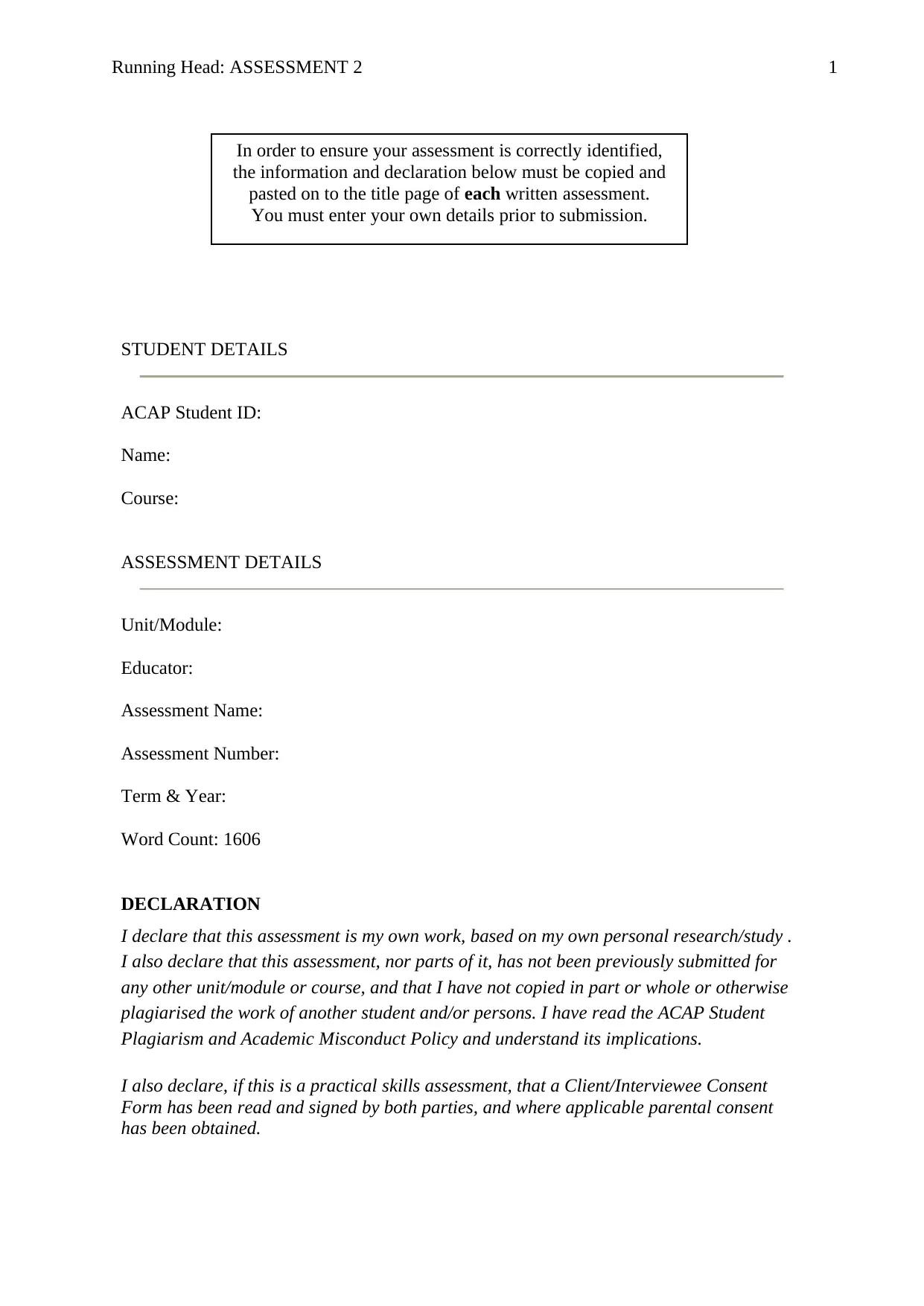
Running Head: ASSESSMENT 2 1
In order to ensure your assessment is correctly identified,
the information and declaration below must be copied and
pasted on to the title page of each written assessment.
You must enter your own details prior to submission.
STUDENT DETAILS
ACAP Student ID:
Name:
Course:
ASSESSMENT DETAILS
Unit/Module:
Educator:
Assessment Name:
Assessment Number:
Term & Year:
Word Count: 1606
DECLARATION
I declare that this assessment is my own work, based on my own personal research/study .
I also declare that this assessment, nor parts of it, has not been previously submitted for
any other unit/module or course, and that I have not copied in part or whole or otherwise
plagiarised the work of another student and/or persons. I have read the ACAP Student
Plagiarism and Academic Misconduct Policy and understand its implications.
I also declare, if this is a practical skills assessment, that a Client/Interviewee Consent
Form has been read and signed by both parties, and where applicable parental consent
has been obtained.
In order to ensure your assessment is correctly identified,
the information and declaration below must be copied and
pasted on to the title page of each written assessment.
You must enter your own details prior to submission.
STUDENT DETAILS
ACAP Student ID:
Name:
Course:
ASSESSMENT DETAILS
Unit/Module:
Educator:
Assessment Name:
Assessment Number:
Term & Year:
Word Count: 1606
DECLARATION
I declare that this assessment is my own work, based on my own personal research/study .
I also declare that this assessment, nor parts of it, has not been previously submitted for
any other unit/module or course, and that I have not copied in part or whole or otherwise
plagiarised the work of another student and/or persons. I have read the ACAP Student
Plagiarism and Academic Misconduct Policy and understand its implications.
I also declare, if this is a practical skills assessment, that a Client/Interviewee Consent
Form has been read and signed by both parties, and where applicable parental consent
has been obtained.
Paraphrase This Document
Need a fresh take? Get an instant paraphrase of this document with our AI Paraphraser
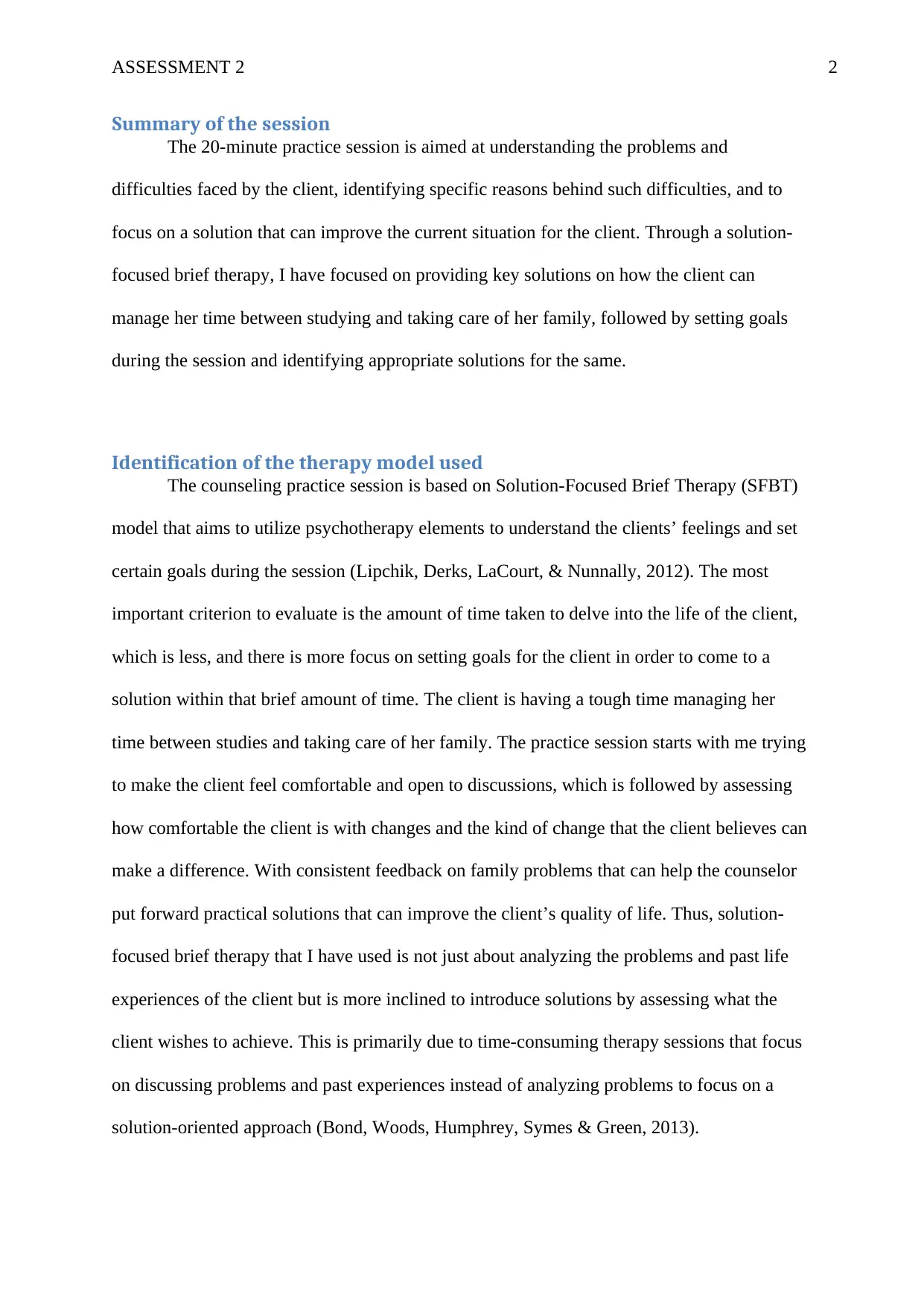
ASSESSMENT 2 2
Summary of the session
The 20-minute practice session is aimed at understanding the problems and
difficulties faced by the client, identifying specific reasons behind such difficulties, and to
focus on a solution that can improve the current situation for the client. Through a solution-
focused brief therapy, I have focused on providing key solutions on how the client can
manage her time between studying and taking care of her family, followed by setting goals
during the session and identifying appropriate solutions for the same.
Identification of the therapy model used
The counseling practice session is based on Solution-Focused Brief Therapy (SFBT)
model that aims to utilize psychotherapy elements to understand the clients’ feelings and set
certain goals during the session (Lipchik, Derks, LaCourt, & Nunnally, 2012). The most
important criterion to evaluate is the amount of time taken to delve into the life of the client,
which is less, and there is more focus on setting goals for the client in order to come to a
solution within that brief amount of time. The client is having a tough time managing her
time between studies and taking care of her family. The practice session starts with me trying
to make the client feel comfortable and open to discussions, which is followed by assessing
how comfortable the client is with changes and the kind of change that the client believes can
make a difference. With consistent feedback on family problems that can help the counselor
put forward practical solutions that can improve the client’s quality of life. Thus, solution-
focused brief therapy that I have used is not just about analyzing the problems and past life
experiences of the client but is more inclined to introduce solutions by assessing what the
client wishes to achieve. This is primarily due to time-consuming therapy sessions that focus
on discussing problems and past experiences instead of analyzing problems to focus on a
solution-oriented approach (Bond, Woods, Humphrey, Symes & Green, 2013).
Summary of the session
The 20-minute practice session is aimed at understanding the problems and
difficulties faced by the client, identifying specific reasons behind such difficulties, and to
focus on a solution that can improve the current situation for the client. Through a solution-
focused brief therapy, I have focused on providing key solutions on how the client can
manage her time between studying and taking care of her family, followed by setting goals
during the session and identifying appropriate solutions for the same.
Identification of the therapy model used
The counseling practice session is based on Solution-Focused Brief Therapy (SFBT)
model that aims to utilize psychotherapy elements to understand the clients’ feelings and set
certain goals during the session (Lipchik, Derks, LaCourt, & Nunnally, 2012). The most
important criterion to evaluate is the amount of time taken to delve into the life of the client,
which is less, and there is more focus on setting goals for the client in order to come to a
solution within that brief amount of time. The client is having a tough time managing her
time between studies and taking care of her family. The practice session starts with me trying
to make the client feel comfortable and open to discussions, which is followed by assessing
how comfortable the client is with changes and the kind of change that the client believes can
make a difference. With consistent feedback on family problems that can help the counselor
put forward practical solutions that can improve the client’s quality of life. Thus, solution-
focused brief therapy that I have used is not just about analyzing the problems and past life
experiences of the client but is more inclined to introduce solutions by assessing what the
client wishes to achieve. This is primarily due to time-consuming therapy sessions that focus
on discussing problems and past experiences instead of analyzing problems to focus on a
solution-oriented approach (Bond, Woods, Humphrey, Symes & Green, 2013).
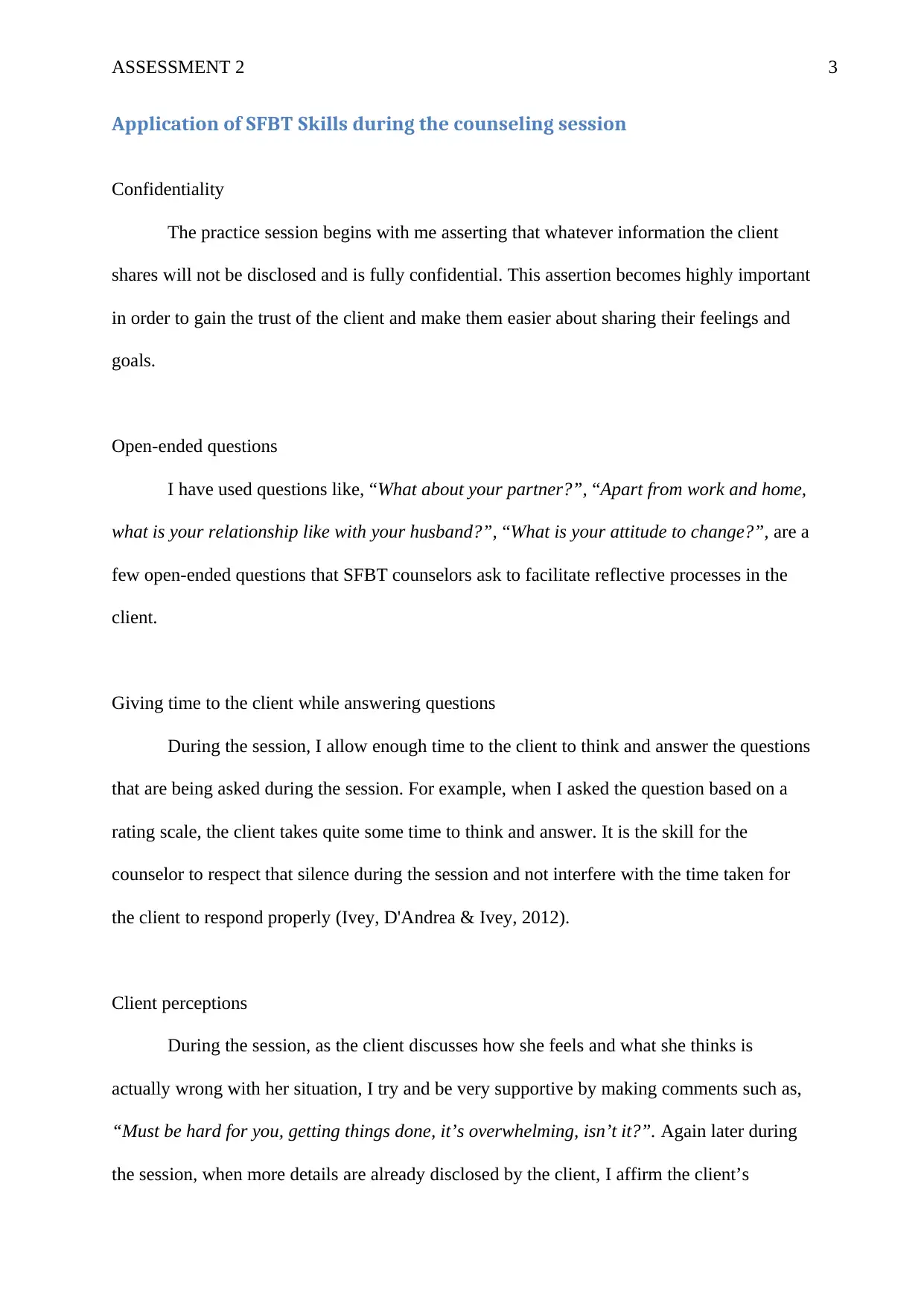
ASSESSMENT 2 3
Application of SFBT Skills during the counseling session
Confidentiality
The practice session begins with me asserting that whatever information the client
shares will not be disclosed and is fully confidential. This assertion becomes highly important
in order to gain the trust of the client and make them easier about sharing their feelings and
goals.
Open-ended questions
I have used questions like, “What about your partner?”, “Apart from work and home,
what is your relationship like with your husband?”, “What is your attitude to change?”, are a
few open-ended questions that SFBT counselors ask to facilitate reflective processes in the
client.
Giving time to the client while answering questions
During the session, I allow enough time to the client to think and answer the questions
that are being asked during the session. For example, when I asked the question based on a
rating scale, the client takes quite some time to think and answer. It is the skill for the
counselor to respect that silence during the session and not interfere with the time taken for
the client to respond properly (Ivey, D'Andrea & Ivey, 2012).
Client perceptions
During the session, as the client discusses how she feels and what she thinks is
actually wrong with her situation, I try and be very supportive by making comments such as,
“Must be hard for you, getting things done, it’s overwhelming, isn’t it?”. Again later during
the session, when more details are already disclosed by the client, I affirm the client’s
Application of SFBT Skills during the counseling session
Confidentiality
The practice session begins with me asserting that whatever information the client
shares will not be disclosed and is fully confidential. This assertion becomes highly important
in order to gain the trust of the client and make them easier about sharing their feelings and
goals.
Open-ended questions
I have used questions like, “What about your partner?”, “Apart from work and home,
what is your relationship like with your husband?”, “What is your attitude to change?”, are a
few open-ended questions that SFBT counselors ask to facilitate reflective processes in the
client.
Giving time to the client while answering questions
During the session, I allow enough time to the client to think and answer the questions
that are being asked during the session. For example, when I asked the question based on a
rating scale, the client takes quite some time to think and answer. It is the skill for the
counselor to respect that silence during the session and not interfere with the time taken for
the client to respond properly (Ivey, D'Andrea & Ivey, 2012).
Client perceptions
During the session, as the client discusses how she feels and what she thinks is
actually wrong with her situation, I try and be very supportive by making comments such as,
“Must be hard for you, getting things done, it’s overwhelming, isn’t it?”. Again later during
the session, when more details are already disclosed by the client, I affirm the client’s
⊘ This is a preview!⊘
Do you want full access?
Subscribe today to unlock all pages.

Trusted by 1+ million students worldwide
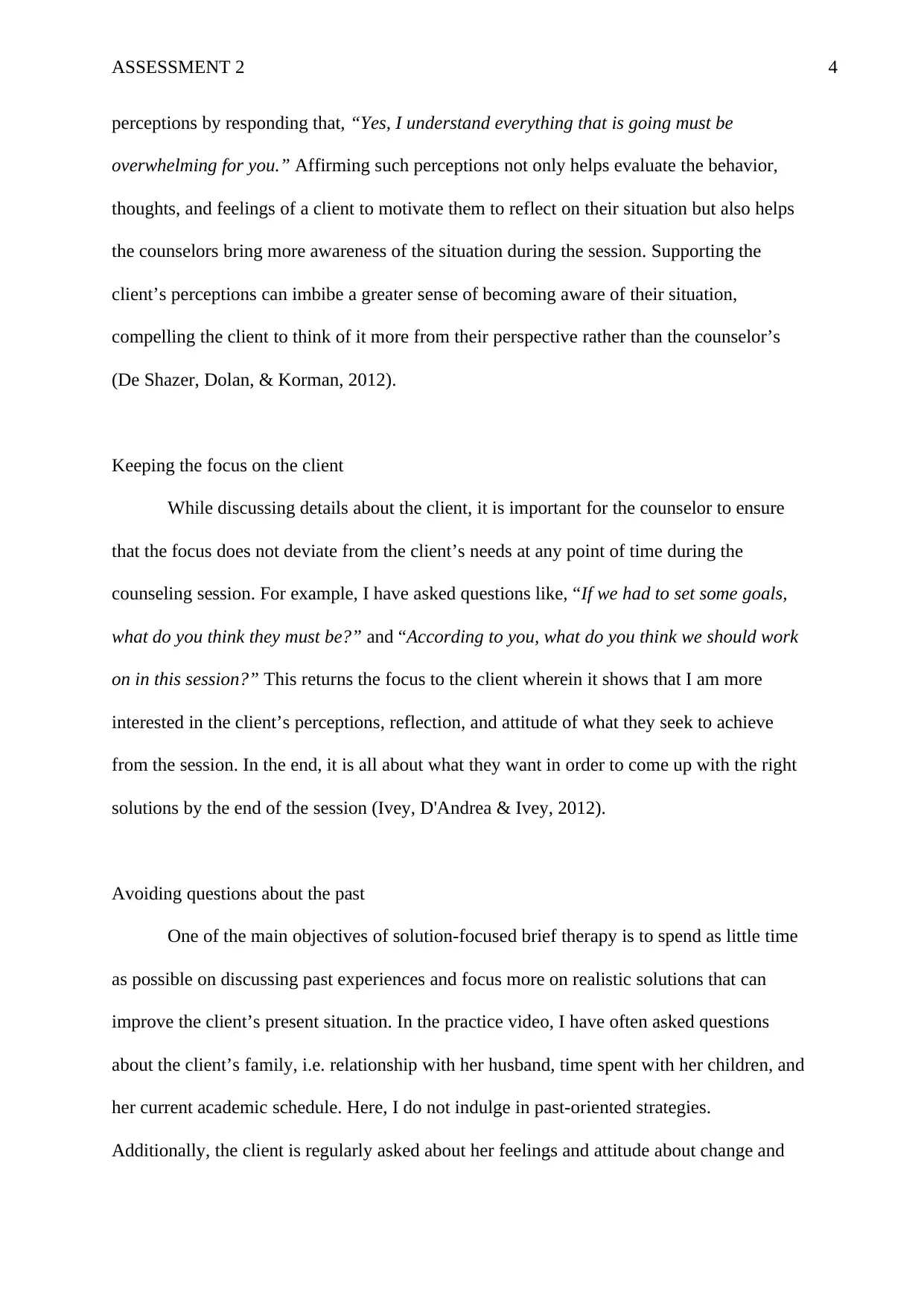
ASSESSMENT 2 4
perceptions by responding that, “Yes, I understand everything that is going must be
overwhelming for you.” Affirming such perceptions not only helps evaluate the behavior,
thoughts, and feelings of a client to motivate them to reflect on their situation but also helps
the counselors bring more awareness of the situation during the session. Supporting the
client’s perceptions can imbibe a greater sense of becoming aware of their situation,
compelling the client to think of it more from their perspective rather than the counselor’s
(De Shazer, Dolan, & Korman, 2012).
Keeping the focus on the client
While discussing details about the client, it is important for the counselor to ensure
that the focus does not deviate from the client’s needs at any point of time during the
counseling session. For example, I have asked questions like, “If we had to set some goals,
what do you think they must be?” and “According to you, what do you think we should work
on in this session?” This returns the focus to the client wherein it shows that I am more
interested in the client’s perceptions, reflection, and attitude of what they seek to achieve
from the session. In the end, it is all about what they want in order to come up with the right
solutions by the end of the session (Ivey, D'Andrea & Ivey, 2012).
Avoiding questions about the past
One of the main objectives of solution-focused brief therapy is to spend as little time
as possible on discussing past experiences and focus more on realistic solutions that can
improve the client’s present situation. In the practice video, I have often asked questions
about the client’s family, i.e. relationship with her husband, time spent with her children, and
her current academic schedule. Here, I do not indulge in past-oriented strategies.
Additionally, the client is regularly asked about her feelings and attitude about change and
perceptions by responding that, “Yes, I understand everything that is going must be
overwhelming for you.” Affirming such perceptions not only helps evaluate the behavior,
thoughts, and feelings of a client to motivate them to reflect on their situation but also helps
the counselors bring more awareness of the situation during the session. Supporting the
client’s perceptions can imbibe a greater sense of becoming aware of their situation,
compelling the client to think of it more from their perspective rather than the counselor’s
(De Shazer, Dolan, & Korman, 2012).
Keeping the focus on the client
While discussing details about the client, it is important for the counselor to ensure
that the focus does not deviate from the client’s needs at any point of time during the
counseling session. For example, I have asked questions like, “If we had to set some goals,
what do you think they must be?” and “According to you, what do you think we should work
on in this session?” This returns the focus to the client wherein it shows that I am more
interested in the client’s perceptions, reflection, and attitude of what they seek to achieve
from the session. In the end, it is all about what they want in order to come up with the right
solutions by the end of the session (Ivey, D'Andrea & Ivey, 2012).
Avoiding questions about the past
One of the main objectives of solution-focused brief therapy is to spend as little time
as possible on discussing past experiences and focus more on realistic solutions that can
improve the client’s present situation. In the practice video, I have often asked questions
about the client’s family, i.e. relationship with her husband, time spent with her children, and
her current academic schedule. Here, I do not indulge in past-oriented strategies.
Additionally, the client is regularly asked about her feelings and attitude about change and
Paraphrase This Document
Need a fresh take? Get an instant paraphrase of this document with our AI Paraphraser
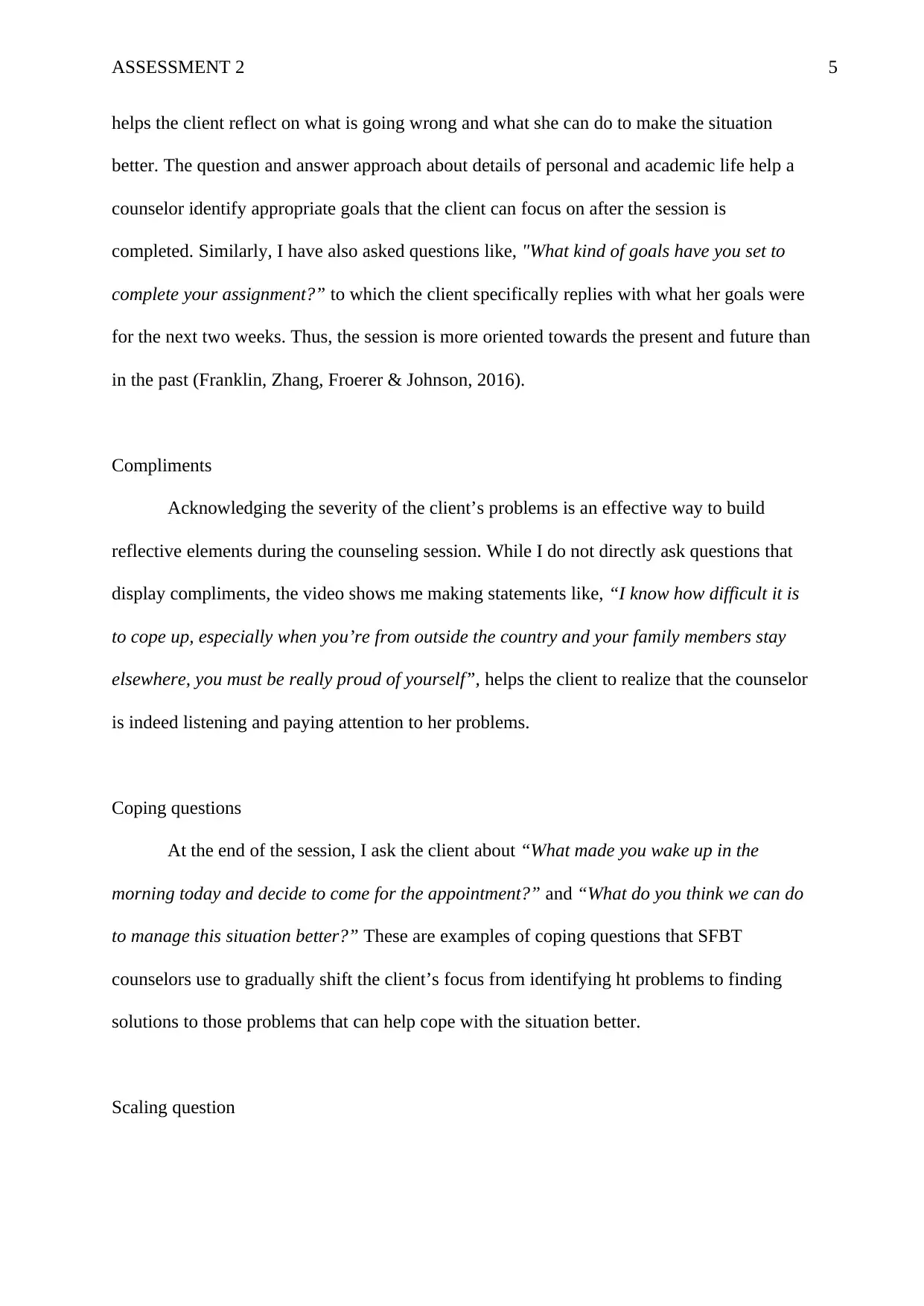
ASSESSMENT 2 5
helps the client reflect on what is going wrong and what she can do to make the situation
better. The question and answer approach about details of personal and academic life help a
counselor identify appropriate goals that the client can focus on after the session is
completed. Similarly, I have also asked questions like, "What kind of goals have you set to
complete your assignment?” to which the client specifically replies with what her goals were
for the next two weeks. Thus, the session is more oriented towards the present and future than
in the past (Franklin, Zhang, Froerer & Johnson, 2016).
Compliments
Acknowledging the severity of the client’s problems is an effective way to build
reflective elements during the counseling session. While I do not directly ask questions that
display compliments, the video shows me making statements like, “I know how difficult it is
to cope up, especially when you’re from outside the country and your family members stay
elsewhere, you must be really proud of yourself”, helps the client to realize that the counselor
is indeed listening and paying attention to her problems.
Coping questions
At the end of the session, I ask the client about “What made you wake up in the
morning today and decide to come for the appointment?” and “What do you think we can do
to manage this situation better?” These are examples of coping questions that SFBT
counselors use to gradually shift the client’s focus from identifying ht problems to finding
solutions to those problems that can help cope with the situation better.
Scaling question
helps the client reflect on what is going wrong and what she can do to make the situation
better. The question and answer approach about details of personal and academic life help a
counselor identify appropriate goals that the client can focus on after the session is
completed. Similarly, I have also asked questions like, "What kind of goals have you set to
complete your assignment?” to which the client specifically replies with what her goals were
for the next two weeks. Thus, the session is more oriented towards the present and future than
in the past (Franklin, Zhang, Froerer & Johnson, 2016).
Compliments
Acknowledging the severity of the client’s problems is an effective way to build
reflective elements during the counseling session. While I do not directly ask questions that
display compliments, the video shows me making statements like, “I know how difficult it is
to cope up, especially when you’re from outside the country and your family members stay
elsewhere, you must be really proud of yourself”, helps the client to realize that the counselor
is indeed listening and paying attention to her problems.
Coping questions
At the end of the session, I ask the client about “What made you wake up in the
morning today and decide to come for the appointment?” and “What do you think we can do
to manage this situation better?” These are examples of coping questions that SFBT
counselors use to gradually shift the client’s focus from identifying ht problems to finding
solutions to those problems that can help cope with the situation better.
Scaling question
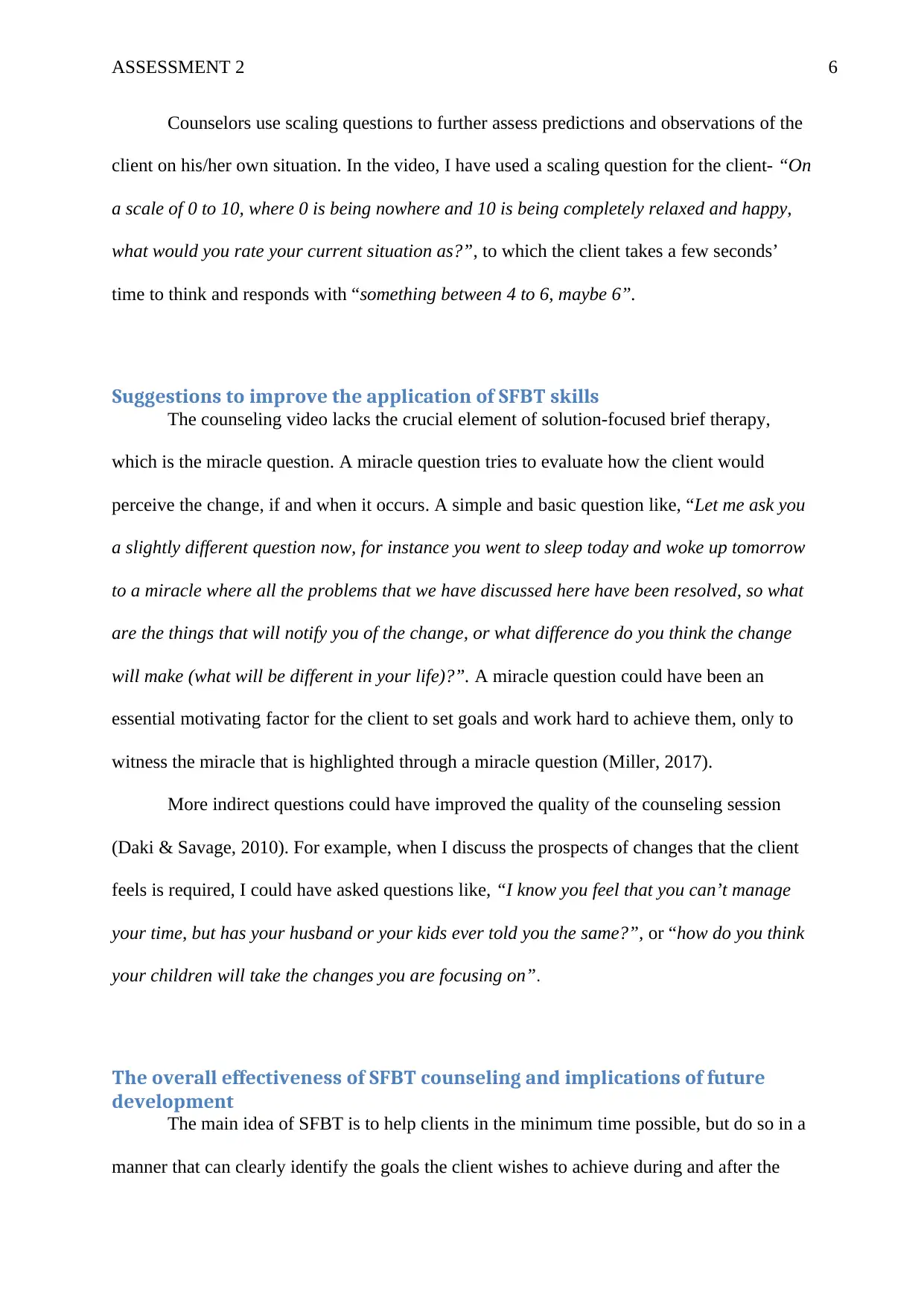
ASSESSMENT 2 6
Counselors use scaling questions to further assess predictions and observations of the
client on his/her own situation. In the video, I have used a scaling question for the client- “On
a scale of 0 to 10, where 0 is being nowhere and 10 is being completely relaxed and happy,
what would you rate your current situation as?”, to which the client takes a few seconds’
time to think and responds with “something between 4 to 6, maybe 6”.
Suggestions to improve the application of SFBT skills
The counseling video lacks the crucial element of solution-focused brief therapy,
which is the miracle question. A miracle question tries to evaluate how the client would
perceive the change, if and when it occurs. A simple and basic question like, “Let me ask you
a slightly different question now, for instance you went to sleep today and woke up tomorrow
to a miracle where all the problems that we have discussed here have been resolved, so what
are the things that will notify you of the change, or what difference do you think the change
will make (what will be different in your life)?”. A miracle question could have been an
essential motivating factor for the client to set goals and work hard to achieve them, only to
witness the miracle that is highlighted through a miracle question (Miller, 2017).
More indirect questions could have improved the quality of the counseling session
(Daki & Savage, 2010). For example, when I discuss the prospects of changes that the client
feels is required, I could have asked questions like, “I know you feel that you can’t manage
your time, but has your husband or your kids ever told you the same?”, or “how do you think
your children will take the changes you are focusing on”.
The overall effectiveness of SFBT counseling and implications of future
development
The main idea of SFBT is to help clients in the minimum time possible, but do so in a
manner that can clearly identify the goals the client wishes to achieve during and after the
Counselors use scaling questions to further assess predictions and observations of the
client on his/her own situation. In the video, I have used a scaling question for the client- “On
a scale of 0 to 10, where 0 is being nowhere and 10 is being completely relaxed and happy,
what would you rate your current situation as?”, to which the client takes a few seconds’
time to think and responds with “something between 4 to 6, maybe 6”.
Suggestions to improve the application of SFBT skills
The counseling video lacks the crucial element of solution-focused brief therapy,
which is the miracle question. A miracle question tries to evaluate how the client would
perceive the change, if and when it occurs. A simple and basic question like, “Let me ask you
a slightly different question now, for instance you went to sleep today and woke up tomorrow
to a miracle where all the problems that we have discussed here have been resolved, so what
are the things that will notify you of the change, or what difference do you think the change
will make (what will be different in your life)?”. A miracle question could have been an
essential motivating factor for the client to set goals and work hard to achieve them, only to
witness the miracle that is highlighted through a miracle question (Miller, 2017).
More indirect questions could have improved the quality of the counseling session
(Daki & Savage, 2010). For example, when I discuss the prospects of changes that the client
feels is required, I could have asked questions like, “I know you feel that you can’t manage
your time, but has your husband or your kids ever told you the same?”, or “how do you think
your children will take the changes you are focusing on”.
The overall effectiveness of SFBT counseling and implications of future
development
The main idea of SFBT is to help clients in the minimum time possible, but do so in a
manner that can clearly identify the goals the client wishes to achieve during and after the
⊘ This is a preview!⊘
Do you want full access?
Subscribe today to unlock all pages.

Trusted by 1+ million students worldwide
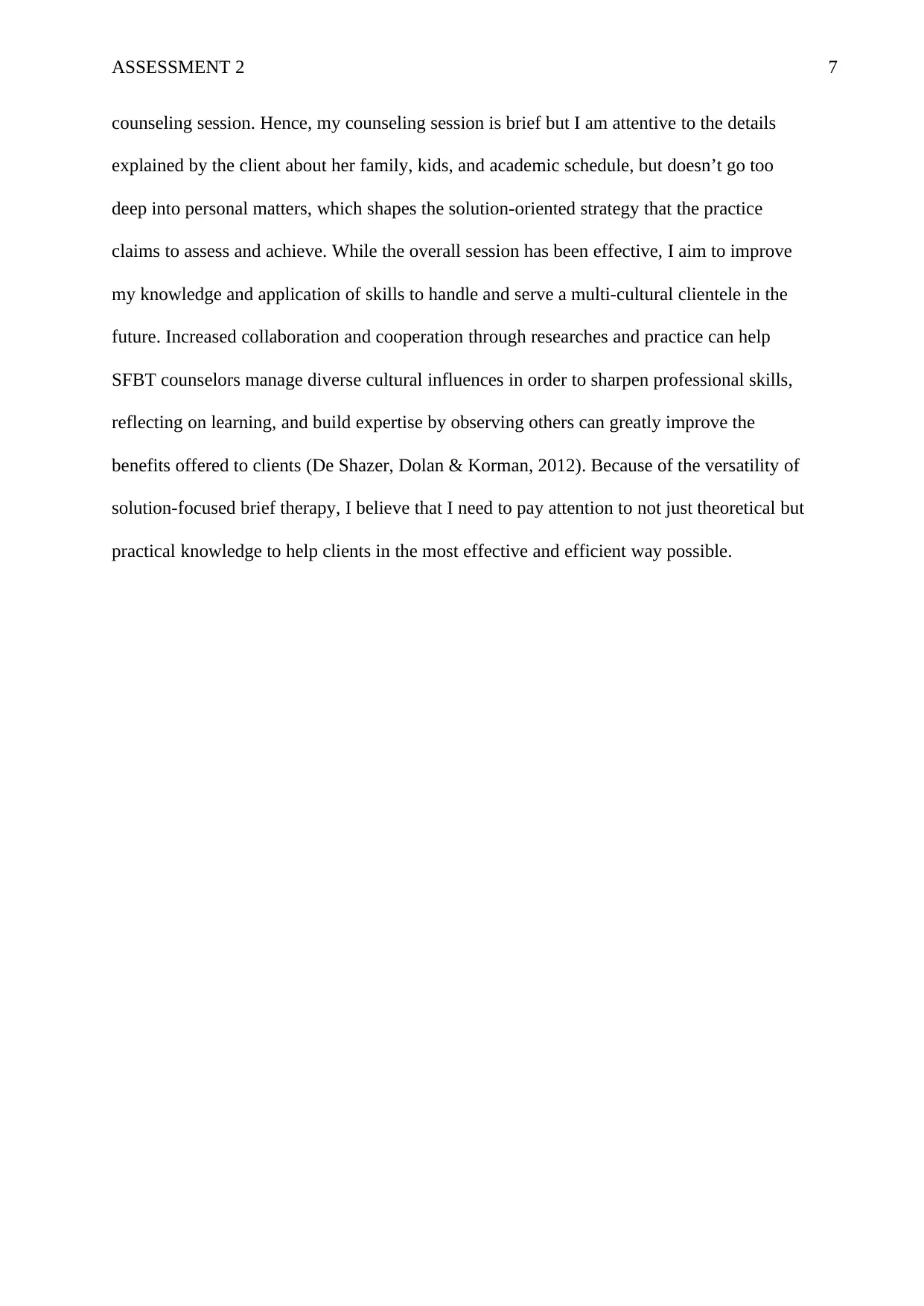
ASSESSMENT 2 7
counseling session. Hence, my counseling session is brief but I am attentive to the details
explained by the client about her family, kids, and academic schedule, but doesn’t go too
deep into personal matters, which shapes the solution-oriented strategy that the practice
claims to assess and achieve. While the overall session has been effective, I aim to improve
my knowledge and application of skills to handle and serve a multi-cultural clientele in the
future. Increased collaboration and cooperation through researches and practice can help
SFBT counselors manage diverse cultural influences in order to sharpen professional skills,
reflecting on learning, and build expertise by observing others can greatly improve the
benefits offered to clients (De Shazer, Dolan & Korman, 2012). Because of the versatility of
solution-focused brief therapy, I believe that I need to pay attention to not just theoretical but
practical knowledge to help clients in the most effective and efficient way possible.
counseling session. Hence, my counseling session is brief but I am attentive to the details
explained by the client about her family, kids, and academic schedule, but doesn’t go too
deep into personal matters, which shapes the solution-oriented strategy that the practice
claims to assess and achieve. While the overall session has been effective, I aim to improve
my knowledge and application of skills to handle and serve a multi-cultural clientele in the
future. Increased collaboration and cooperation through researches and practice can help
SFBT counselors manage diverse cultural influences in order to sharpen professional skills,
reflecting on learning, and build expertise by observing others can greatly improve the
benefits offered to clients (De Shazer, Dolan & Korman, 2012). Because of the versatility of
solution-focused brief therapy, I believe that I need to pay attention to not just theoretical but
practical knowledge to help clients in the most effective and efficient way possible.
Paraphrase This Document
Need a fresh take? Get an instant paraphrase of this document with our AI Paraphraser
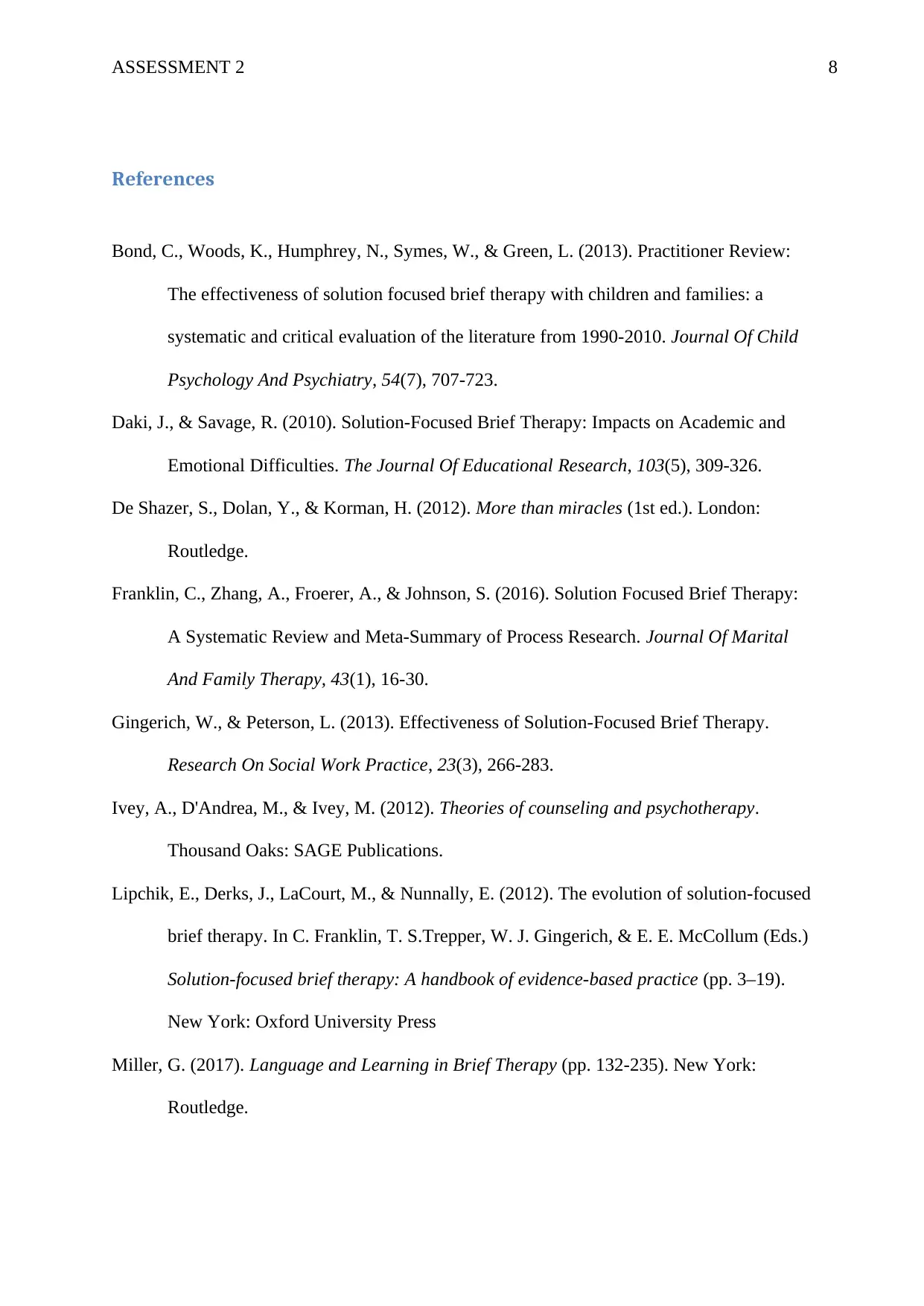
ASSESSMENT 2 8
References
Bond, C., Woods, K., Humphrey, N., Symes, W., & Green, L. (2013). Practitioner Review:
The effectiveness of solution focused brief therapy with children and families: a
systematic and critical evaluation of the literature from 1990-2010. Journal Of Child
Psychology And Psychiatry, 54(7), 707-723.
Daki, J., & Savage, R. (2010). Solution-Focused Brief Therapy: Impacts on Academic and
Emotional Difficulties. The Journal Of Educational Research, 103(5), 309-326.
De Shazer, S., Dolan, Y., & Korman, H. (2012). More than miracles (1st ed.). London:
Routledge.
Franklin, C., Zhang, A., Froerer, A., & Johnson, S. (2016). Solution Focused Brief Therapy:
A Systematic Review and Meta-Summary of Process Research. Journal Of Marital
And Family Therapy, 43(1), 16-30.
Gingerich, W., & Peterson, L. (2013). Effectiveness of Solution-Focused Brief Therapy.
Research On Social Work Practice, 23(3), 266-283.
Ivey, A., D'Andrea, M., & Ivey, M. (2012). Theories of counseling and psychotherapy.
Thousand Oaks: SAGE Publications.
Lipchik, E., Derks, J., LaCourt, M., & Nunnally, E. (2012). The evolution of solution-focused
brief therapy. In C. Franklin, T. S.Trepper, W. J. Gingerich, & E. E. McCollum (Eds.)
Solution-focused brief therapy: A handbook of evidence-based practice (pp. 3–19).
New York: Oxford University Press
Miller, G. (2017). Language and Learning in Brief Therapy (pp. 132-235). New York:
Routledge.
References
Bond, C., Woods, K., Humphrey, N., Symes, W., & Green, L. (2013). Practitioner Review:
The effectiveness of solution focused brief therapy with children and families: a
systematic and critical evaluation of the literature from 1990-2010. Journal Of Child
Psychology And Psychiatry, 54(7), 707-723.
Daki, J., & Savage, R. (2010). Solution-Focused Brief Therapy: Impacts on Academic and
Emotional Difficulties. The Journal Of Educational Research, 103(5), 309-326.
De Shazer, S., Dolan, Y., & Korman, H. (2012). More than miracles (1st ed.). London:
Routledge.
Franklin, C., Zhang, A., Froerer, A., & Johnson, S. (2016). Solution Focused Brief Therapy:
A Systematic Review and Meta-Summary of Process Research. Journal Of Marital
And Family Therapy, 43(1), 16-30.
Gingerich, W., & Peterson, L. (2013). Effectiveness of Solution-Focused Brief Therapy.
Research On Social Work Practice, 23(3), 266-283.
Ivey, A., D'Andrea, M., & Ivey, M. (2012). Theories of counseling and psychotherapy.
Thousand Oaks: SAGE Publications.
Lipchik, E., Derks, J., LaCourt, M., & Nunnally, E. (2012). The evolution of solution-focused
brief therapy. In C. Franklin, T. S.Trepper, W. J. Gingerich, & E. E. McCollum (Eds.)
Solution-focused brief therapy: A handbook of evidence-based practice (pp. 3–19).
New York: Oxford University Press
Miller, G. (2017). Language and Learning in Brief Therapy (pp. 132-235). New York:
Routledge.

ASSESSMENT 2 9
⊘ This is a preview!⊘
Do you want full access?
Subscribe today to unlock all pages.

Trusted by 1+ million students worldwide

ASSESSMENT 2 10
1 out of 10
Related Documents
Your All-in-One AI-Powered Toolkit for Academic Success.
+13062052269
info@desklib.com
Available 24*7 on WhatsApp / Email
![[object Object]](/_next/static/media/star-bottom.7253800d.svg)
Unlock your academic potential
Copyright © 2020–2025 A2Z Services. All Rights Reserved. Developed and managed by ZUCOL.





